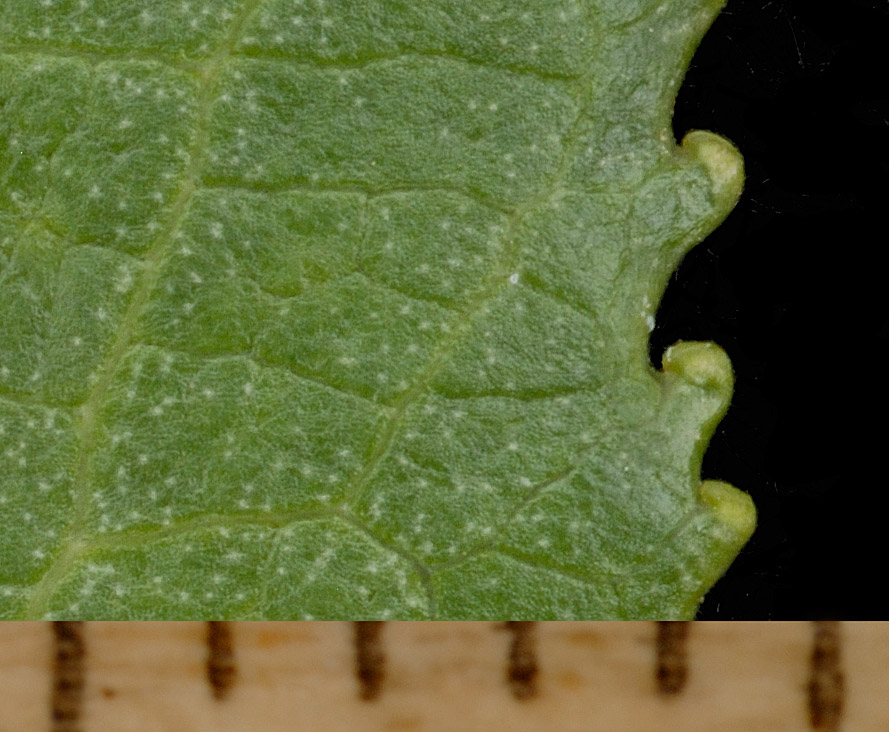 |
Lucida: Answers
to key questions in Conifers & Catkin-Bearing Trees and Shrubs of
Saskatchewan, Fascicle 5, Flora of Saskatchewan by Anna Leighton leading
to this species. The answers are in the order you would normally work
through the key.
 |
Catkins
usually flowering as leaves emerge, sometimes just before leaves emerge
or throughout the season, subtended by small green leaves of the
flowering branchlet that supports them. NOT [Catkins usually
flowering before leaves emerge, borne directly on bare branches
(sessile) and subtended by 1 - 3 short, greenish or brownish, caducous
bract-like leaves] |
 |
Low to
tall shrubs or trees; not confined to subarctic regions. NOT
[Dwarf shrubs <= 0.15 m (15 cm) tall; subarctic regions] |
 |
Shrubs,
usually with several stems; ovaries glabrous or hairy. NOT
[Trees, with a single trunk, or with several trunks of tree stature;
ovaries glabrous] |
 |
NOT
[Plants flowering as leaves emerge or throughout the season, often
bearing branched catkins; leaf blades linear or strap-shaped, 9 – 14
– 24 times longer than wide, up to 11 mm wide with margins remotely
spinulose-serrulate, the teeth widely spaced; hairs on leaves white,
ferruginous hairs lacking; plants forming extensive colonies by root
shoots] |
 |
Petioles
with glandular dots or lobes at distal end; floral bracts pale tawny,
1.2 – 4 mm, conspicuous during flowering, deciduous after flowering.
NOT [Petioles without glandular dots or lobes at distal end, or
with occasional, inconspicuous dots; floral bracts not as above, if
conspicuous and pale, then not deciduous.] |
 |
Catkins
slender to stout or subglobose; fruiting catkins not typically retained
on branches throughout the summer; leaf blades 55 – 180 mm, upper and
lower surfaces glabrous or hairy, apices caudate or acuminate; lower
surfaces of juvenile leaf blades glabrous or hairy with white or some
ferruginous hairs; petioles glabrous, pilose or villous; stipules on
early leaves foliaceous or rudimentary, on late leaves foliaceous,
(sometimes early deciduous on Salix lucida but stipules scars should be
visible). NOT [Catkins stout to globose; fruiting catkins firm and
retained on branches until late summer to early fall when the seed is
shed; leaf blades 43 – 90 mm, upper and lower surfaces glabrous,
apices usually acuminate, sometimes caudate or acute; lower surfaces of
juvenile leaf blades glabrous; petioles glabrous; stipules on early and
late leaves absent or rudimentary.] |
 |
Catkins 20
- 50 mm; lower surfaces of leaf blades not glaucous, or rarely so;
restricted in distribution. NOT [Catkins 14 – 90 mm; lower
surfaces of leaf blades glaucous; widely distributed in the Aspen
Parkland and boreal forest regions.] |
 |
In SK,
found only in the east-central region of the province. NOT [In SK,
found only in Cypress Hills.]
|
|
 |
Salix: Answers
to key questions in Conifers & Catkin-Bearing Trees and Shrubs of
Saskatchewan, Fascicle 5, Flora of Saskatchewan by Anna Leighton leading
to this genus.
 |
shrubs or trees; NOT [trees] |
 |
buds covered by 1 scale; NOT [buds
covered by 3-10 scales] |
 |
buds scale not resinous; NOT [bud scale
usually resinous] |
 |
catkins sessile or terminating flowering
branchlets; NOT [catkins sessile] |
 |
catkins erect, spreading, or +/-
pendulous; NOT [catkins pendulous] |
 |
floral bracts entire, erose, bifid, or
irregularly toothed; NOT [floral bracts deeply cut] |
 |
perianth reduced to an adaxial nectary
(rarely also an abaxial nectary, then the 2 nectaries distinct or
connate into a shallow cup); NOT [perianth reduced to a
non-nectariferous, cup-shaped or shallow saucer-shaped floral disc] |
 |
stamens 1, 2, or 3 – 10; NOT [stamens 6
– 60 (70)] |
 |
capsules obclavate to ovoid or ellipsoid;
NOT [capsules narrowly ovoid to spherical, with the floral disc
persistent at base] |
 |
capsules 2-valved; NOT [capsules 2 - 4
valved] |
|

